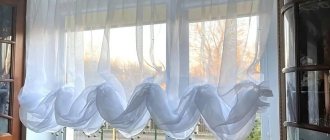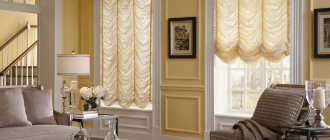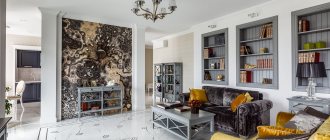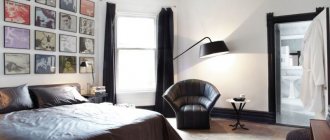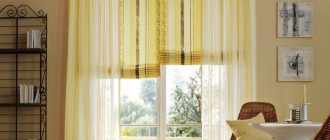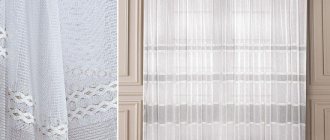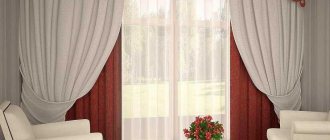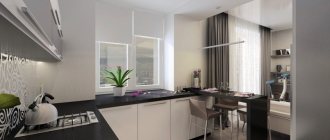Peculiarities
Suitable tulle in the interior (photos of numerous products are given in the article) will be an excellent accent or neutral background for decor. It is transparent, smooth or openwork. The color can be either bright or neutral.
The product protects the room from the sun's rays and lets them through, dispersing them. This creates an airy and cozy atmosphere in the room. The lightweight material drapes perfectly and holds its desired shape.
How to choose?
What are the features of choosing a product? This should be done according to the following principles:
- It is important that the tulle and curtains contrast or complement each other, differing in tones. If there is a pattern on the curtains, then the tulle should also have the same or be neutral.
- The fabric must be chosen to match the style and color of the interior based on whether the accent will be on the window or the tulle will be the background for the rest of the interior.
- If there is no specific style, then it is better to choose a product in neutral beige and white tones that do not have a prominent pattern.
- When sewing individually, it is necessary to take into account the peculiarities of the material, shrinkage, and then washing. It is better to choose curtains from the photo. Tulle in the interior will then look harmonious.
- If you choose a natural material, it is important to consider that fabric with polyester wrinkles less. It is important that it is impregnated with an antistatic and dirt-repellent agent, especially if the textile is intended for the kitchen.
Taking into account these recommendations, you will be able to choose high-quality curtains that will decorate your decor. The products make the room cozy and neat.
Types of striped curtains
Curtains and drapes differ in types of fabrics, patterns and sizes. Before you decorate a room in a certain style, it is better to think in advance which interior items will go well with striped canvases. This is a very “capricious” geometric pattern that requires careful selection of other elements. Kinds:
- wide vertical stripe - suitable for large spacious rooms with low and medium-height ceilings;
- wide horizontal stripe - looks good in halls and living rooms with high ceilings but a small area;
- a narrow vertical stripe is a good option for medium and small rooms;
- a narrow horizontal strip is the optimal solution for high rectangular window openings;
- the intersection of horizontal and vertical stripes perpendicularly is a universal option;
- stripes intersect diagonally - create an atmosphere of calm and orderliness in any room.
With horizontal stripes
These can be calm transitions of colors: blue - blue, beige - brown, turquoise - lilac.
Or bright contrasts when, for example, neutral white is used with other rich shades.
The stripes can be the same width or different. But you need to remember that very wide or too narrow horizontal stripes are more difficult to fit into the interior than stripes of medium width that are calmer for perception. Striped curtains placed in a window opening between narrow walls will expand the space, but at the same time visually reduce the height of the ceiling.
Stripes can be different in color and width.
With vertical stripes
Curtains with a vertical pattern are very convenient to use in rooms with medium-height or low ceilings. This visual illusion helps you model the space as you wish. If you also use a string cornice, which will be disguised under the drapery, then the ceilings will seem noticeably higher.
Vertical stripes visually increase the height of the ceilings.
Wide stripes draw attention to themselves. If in the interior of the room there are 1-2 more objects with a similar pattern, then the problem of proper zoning of the space can be solved very easily and quickly. Medium and narrow stripes look good in small rooms.
Kinds
A suitable tulle can make the room spacious and disguise an uneven window opening. Now there are many options available, differing in texture, color, and size. The most popular types include the following:
- Standard. The curtain does not have large images; it is made of cotton and organza. The product has a simple design and can be combined with curtains. It is advisable to wash it by hand, after soaking it in advance, without twisting it. Ironing is done on a delicate setting using a cloth or damp gauze.
- Tulle mesh. In the interior, this option looks attractive. The grids differ in cell sizes and are considered the background for curtains. The product is made from thin and thick weaves of thread. Tulle mesh in the interior (photo below) makes the room cozy, no matter in which room it is hung. The product should not be used alone as it does not provide protection from the sun. Tulle mesh in the interior goes well with curtains.
- With embroidery. This product is often found in interiors. Embroidery can be of different sizes; metallized and silk threads are used for it. Complex designs, golden monograms on a cream shade are ideal for classics, floral colored embroidery is chosen for country. Embroidery with lines and simple geometry in the interior is perfect for minimalism and modern style.
- Striped tulle. In the interior, it allows you to adjust the perception of space. Moreover, the stripes can be vertical or horizontal. Narrow or wide lines are divided into plain and combined. The inserted stripes are either satin or embroidered.
- Cobweb. It includes weaves of silk and synthetic threads. This product looks weightless, but is durable. He doesn't need ironing. There is embroidery on the web. Such products are used independently and in combination with curtains.
- Kisey, noodles or thread curtains. Products come in different densities, with or without bead decoration. They perfectly shade the room, drape well, and do not wrinkle. They can be used to decorate the door to the loggia. They are also used as a partition for different zones in the same room. Combined with blinds.
- The tulles in the interior differ in their patterns. They can be embroidered, embossed, sewn. Jacquard images, curls, products with flowers are ideal for a classic style. Geometry and lines look great with neutral curtains.
- Rain tulle has this name because a dense thread is woven into a plain material, which is similar to rain. It attracts attention, but is also neutral; it is chosen for a rich interior. The product comes with a vertical or horizontal gradient.
- Floral tulle is used for country and Provence. The floral design should fit harmoniously into the atmosphere of the room. Bright images look great against a neutral wall background; lush drapery is not suitable because the pattern will not be noticeable.
- Lace product. Such tulle in the interior allows you to complement the surrounding details. Usually it is chosen for the bedroom, terrace, living room. The openwork on the veil can be sewn, embroidered or bobbin. The material can be completely lace or with inserts. It creates comfort, allows light to pass through, and serves as protection from prying eyes.
- Pleated. The material is like a reaper. The fabric does not wrinkle and has high plasticity. Pleated panels allow light to pass through, but block the sun's rays, so this option is ideal for south-facing windows.
Tulle and curtains in the interior (photos of possible products are presented in the article) look neat if they are chosen in accordance with the style of the room. Matching curtains make the environment cozy.
Products vary in length. Short ones are usually chosen for the kitchen: they will not get in the way and will create a cozy atmosphere. Long ones are more suitable for the bedroom and living room. If the average length of the products is when they cover the entire window, but do not reach the floor. When choosing this option, you need to take into account the general style of the room. It is also important to rely on the features of the window.
What fabrics are suitable for French curtains
French curtains in the interior are far from the most economical way to decorate windows. They will require several times more fabric than ordinary curtains. In addition, scallop folds on cheap fabrics look ugly and primitive and, despite the fact that modern awnings do not have to be sewn as they once were from expensive natural silk, you won’t be able to save significantly on textiles either.
Before choosing the French version of curtains, it is advisable to carefully weigh the costs of their production and make sure that they fit well into the interior and the money spent on them will be compensated by the beauty and harmony of the environment.
To make the folds look impressive, even and smooth, you need to choose a well-draped, light and soft fabric. These conditions are best met by natural or mixed textiles, with a small addition of polyester fibers:
- tulle;
- fine silk;
- chiffon;
- batiste;
- moire;
- muslin;
- veil;
- organza.
Such curtains look light and delicate and are used as curtains, both independently and together with curtains made of taffeta, satin, velvet, and brocade. At the same time, the curtains should also look luxurious and not get lost in the splendor of French curtains.
French curtains made of satin fabric
Sometimes awnings are sewn from dense, but thin, soft and well-draped fabrics. It could be:
- velvet;
- velours;
- curtain wool.
Such curtains do not need partners and look elegant and respectable. Any curtains hung with them will be unnecessary. But you need to keep in mind that windows with thick opaque awnings look “deaf” and they are suitable only for spacious rooms and classic interiors corresponding to their status with massive furniture made of natural wood and gilded or bronze accessories.
French velvet curtains
The appearance of the folds depends entirely on the texture of the fabric: the softer and heavier it is, the more laconic and smooth the scallops are. And, conversely, the stiffer and lighter the material, the more magnificent and prominent they are.
As for the colors, only plain fabrics are suitable for curtains of this type. Any pattern will be lost in numerous festoons, it will look broken, and the curtain will be untidy.
Materials
Thin materials that allow air and sunlight to pass through are used for sewing. Usually this:
- organza;
- veil;
- muslin;
- net.
Organza is a durable, almost transparent material. It is performed by tightly twisting threads of the same thickness. The advantage of the fabric is that it almost does not accumulate dust. It is created from silk or synthetic threads.
Voile curtains are universal. They are created from artificial fabrics - cotton, silk, wool, polyester. The veil is soft, delicate, less transparent than organza.
Kisey is a light, transparent cotton fabric containing separately located threads. It is easy to care for, does not wrinkle, and can be cleaned at home.
The mesh has a perforated structure. Curtains allow air and sunlight to pass through, but quickly accumulate dust and require frequent washing. It is embroidered with silk threads, which looks impressive.
Colors
Which tulle to choose for the interior? The following colors are in demand:
- White. Usually choose a product in this pure color. A milky or ivory tone would be suitable. White tulle in the interior provides a light atmosphere, ideal for small apartments.
- Grey. It is a neutral color that creates a veil effect. A dark tone should be chosen for a large room, and a light one for a small one.
- Black. Care must be taken with it, for example, when combined with a white or light floor, ceiling or walls.
- Brown. This color in a chocolate shade harmonizes with milky curtains. Brown has a great effect on creating coziness.
- Beige. The color is ideal for a multi-colored interior, harmonizes with different shades. Can make a room brighter.
- Red. It attracts attention, puts emphasis, and does not require addition. It is necessary that red be used in decorative elements, for example, in a carpet or figurine.
- Yellow. Suitable for dimly lit and cool rooms. Tulle harmonizes perfectly with brown, white, and blue curtains.
- Orange. The color warms the interior, highlighting the window. Great for kitchen, living room, bedroom. Allows you to emphasize activity and positivity.
- Gold. Considered a classic for tulle. It is better to choose for a classic living room and bedroom. The color is in harmony with white, black, burgundy.
- Pink. Pastel pink can highlight the tenderness of a bedroom or nursery. The color goes well with light gray furniture and white wallpaper.
- Blue. Such curtains cool a hot room; they should not be combined with dark curtains. The color is in harmony with beige, white, yellow.
- Turquoise. The color relaxes and sets the mood for relaxation; it is advisable to choose it for the bedroom and living room. Mint tones are refreshing and harmonize with yellow, red, and white walls.
- Lilac. Allows you to emphasize the dynamism of the interior, which will always be fresh and interesting. The product can be complemented with white or black embroidery.
Stripes in the interior
Such a simple and yet effective pattern as a stripe can be introduced into the interior of any room. At the same time, the nuances of style and design are taken into account, and the functional purpose of the room is also taken into account.
Living room
This room unites all family members and serves as a place for receiving guests. Therefore, it is so important that curtains are selected for the living room, creating a feeling of volume and “making” the space larger.
At the same time, striped curtains should not be overly boring. Their colors can be selected in such a way that the shades that are present on the fabric are in tune with other decorative elements in the interior. For the living room, not only dense material can be selected, but also light tulle, mesh or translucent options, suitable for modern interiors.
Advice! Beautiful tiebacks and decoration elements can be used as additional decoration for curtains. For example, tassels, fringe, cords, interesting lambrequins, etc.
Children's
A child's room needs space and light. It is advisable to choose curtains with horizontal or vertical stripes in calm, non-irritating shades. Eco-friendly cotton and fine linen are the best materials for curtains.
The choice of colors depends on the style of the room and the age of the child. You can also decorate the children's windows in an original way with Roman blinds with a striped pattern.
Advice! One of the interesting options that boys will like is nautical themed styling: choosing blue and white curtains.
Kitchen
This room should combine convenience with practicality and attractiveness. For the kitchen, it is important to choose a fabric that will withstand frequent washing, provide shade from the bright sun and emphasize the stylishness of the interior design.
You also need to take into account the size of the room. If the space is small, then you can choose short curtains with bright stripes in cheerful or contrasting colors.
See also: Roman blinds for kitchen interiors
Bedroom
In this room, all the design should be extremely balanced, promoting good rest and healthy sleep. If the windows face south, then the curtains should provide sufficient shading. In this case, the choice may be in favor of fairly dense fabrics. Universal designs suitable for many interiors include curtains in soothing light colors with alternating narrow vertical or horizontal stripes.
Size and illumination
Volumetric products with embroidery, lace, ruffles, and patterns are great for spacious rooms. This is an excellent choice for large halls, bedrooms, and living rooms. In dark rooms with a lot of furniture, these curtains are inappropriate; they create a feeling of clutter.
Large images or openwork parts decorate the tulle of the south window. A dark curtain - gray, blue, purple - will protect you from the very bright sun. You should choose cool shades. For small, poorly lit rooms, transparent tulles, plain or decorated with small patterns and thin lace, are suitable. The product must be combined with light curtains.
For northern windows, light curtains in warm colors are preferable. They eliminate the lack of light and create the effect of sunlight that penetrates the window.
Combination with curtains
Although the product can be used independently, it can be supplemented with other shading elements. Curtains and tulle in the interior can make the atmosphere cozy if you choose them correctly. The following combinations are in demand:
- With curtains. This option is suitable for different styles. Products come in single colors and multi-colors. With this combination, the pattern must be present on one item. You should not choose curtains made of natural material and organza tulle.
- With roller blinds. The combination will be perfect if the tulle is transparent. When rolled up, the roll is invisible.
- With a Roman blind. They are chosen for a modern living room, nursery, bedroom. They are fixed to the sash or opening. The color of the product can be the same or contrasting.
- With a thread curtain. The main thing is to choose curtains and tulle in different colors. Thread products should be thick, and the tulle should be openwork or translucent.
Cornice for French curtains
The cornice for French curtains can be the same as the cornice for Roman blinds. Depending on the model, it is equipped with a lifting mechanism or a simplified version is used. The fabric can be fastened with Velcro tape or hooks. The photo below shows standard cornices for French curtains with an open and closed curtain lifting mechanism.
It is worth noting that regardless of what fabric (thick or transparent) was used for sewing, thanks to the abundant and complex drapery, the awning is able to completely protect the interior space of the room from views from the street.
Styles
With the help of this universal decor you can emphasize different interior styles:
- Modern. For it, it is better to choose a plain product, striped, with small embroidery. The color can be any, the main thing is that it is appropriate in the decor. Simple lines, clear fabric without asymmetry are relevant.
- Classic. This style assumes consistency and a combination of heavy brocade or velvet curtains with light patterned beige muslin. There may be soft lambrequins or throws with fringe and tassels.
- Provence. The light texture of the material is suitable for it, which can be easily draped into lush folds on the sides of the window. Mesh, tulle with embroidery and floral patterns are used. The length varies, it all depends on the interior.
- Scandinavian. The style does not use heavy curtains, so you can choose white muslin without openwork. It is combined with a roller blind.
Use in different rooms
As you can see in the photos above, tulle in the living room interior allows you to transform the room. It is better to choose organza, noodles, and openwork products. The length can be up to the floor.
And the method of fastening is determined depending on the desired drapery. Custom embroidery or photo printing looks great. White or beige tulle in the living room interior is chosen for classics. The product goes well with dark and light furniture.
Tulle in the kitchen interior will look harmonious if you choose a medium length. You should choose a synthetic blend that will not burn, wrinkle, or fade after washing. A kitchen with such curtains will be cozy.
Tulle also looks attractive in the bedroom interior. Cobwebs, rain, embroidery in pastel colors are suitable. The product is combined with curtains and lambrequins, Roman blinds, but they are also used as an independent attribute.
Colored tulle is ideal for a children's room. It may have a photo print with cartoon characters. The length should be chosen according to the age of the child. The room needs to be shaded for daytime sleep, so roller blinds or thick drapes are an indispensable item.
Black curtains and tulle in the interior - tips for use in different rooms
Black tulle can significantly diversify the design of a room. At the same time, it will not look organic in every room, even if all the necessary conditions are met. A very important point when using them is the direction of the room and its orientation. In general, black tulle or curtains can be used for decoration, but subject to the following conditions:
- Placing black curtains in the bedroom is a great solution as this room is meant for relaxation and rest. Based on this, in addition to tulle or curtains, you can use other elements of dark shades, for example, wallpaper or furniture. It is advisable that their surface have a glossy base, since matte coatings help darken the room.
- You need to use black curtains in the living room wisely so as not to destroy the interior into separate parts. To do this, you need to support them with some decorative element or piece of furniture. Shiny lacquered or glass surfaces of tables and shelves look much more elegant and richer than the upholstery of upholstered furniture.
- Excessively dark curtains in charcoal shades look quite dull in any interior, so it is better to try to hide them by diluting them with light tones of cornices or embossed wallpaper.
- It is not recommended to use black curtains or tulle to decorate children's rooms or kitchens. In the first option, they will make the room too gloomy, creating a sharp contrast between the bright and colorful coverings that predominate in the nursery. In the kitchen, their use is simply impractical, since the slightest stains and dirt will be immediately noticeable, which will immediately affect the appearance of the room.
You may also be interested in: Rules for using gray tulle with photo examples
Not all rooms can be decorated with black curtains. However, if all necessary conditions are met, a bedroom or living room can acquire unprecedented elegance and conciseness.
Save
Drapery
Various types of draperies are used to decorate products. These can be “bow folds”, “Roman curtains”, “French wicker”, lambrequin. In the first case, the product is supposed to be collected in small folds, like bows. The material is secured by a stitch at the top of the curtain.
The “Roman blinds” method involves the presence of a cord along the product. With it, the fabric gathers and creates semicircular folds. “French braiding” involves stitching the curtain along the length at the same distance. The marked areas of the material are fanned out and stitched again. This method requires thick fabric.
The lambrequin is a decorative detail of the tulle drapery, located horizontally at the top. This is a strip of fabric that covers the cornice. The lambrequin is decorated with braid, tassels, and ruffles. Such accessories make the product luxurious.
On the eyelets
Eyelets are usually used for modern designs. They are also used for classical, country, baroque. The rings located at the top of the tulle and fixed near the holes for the cornice help to get beautiful waves on the material. The tulle on the eyelets also slides perfectly along the cornice. It moves easily, opens and closes.
Eyelets are made of metal, plastic, wood or other durable materials. If these products are used, the tulle should be wide, since a small amount of material does not create an original drapery. The fabric can be either thin or dense with a textured pattern. If the materials are transparent and translucent, the folds will be voluminous.
Thus, tulle in the interior is an important element. If you choose it correctly, you will get a cozy and comfortable atmosphere in any room.
Attaching to the cornice
In addition to differences in design, tulle can be attached to the cornice in different ways:
- With ties. This type of fastening is quite universal. Ribbons are sewn to the canvas and tied in a bow on the cornice. The denser and heavier the fabric, the thicker the ties should be. This method looks especially beautiful on weightless natural fabrics of the same tone or with a floral technique. In addition, it can be a curtain made of mesh or tulle.
- On hinges. Decorative loops are sewn on top of the curtains. They are convenient because you don’t need to tie each one by hand, as in the previous version, but simply string them onto a cornice. This is one of the most popular mounts. The number of loops mainly depends on the weight of the curtains. Depending on the style of the room, the loops can be the same or different widths, from the same fabric as the curtain or different.
- On the eyelets. These are rings inserted into the curtain that are hung on the curtain rod. They can be made of metal or plastic. Typically, a grommet consists of a block and a ring. The design is very durable and easy to use. Curtains with eyelets glide well along the cornice, due to which you can easily make beautiful folds, and the wear resistance of the curtains increases,
You might be interested in this Features of Kviv Avto eco-leather for car interiors
Fastening to the cornice with grommets
- On the drawstring. Pockets are made on top of the canvas along the entire length. These pockets are strung on the cornice and thus the tulle is attached. The advantage of this method is maximum noiselessness when opening and closing curtains. Most often, this fastening is done on straight curtains.
- On the braid. This type of fastening is as simple as possible, but at the same time it looks very advantageous. The top of the tulle is gathered with drapery, due to this the entire fabric is formed in beautiful frequent folds. The drapery is obtained by sewing cords into the braid, which are pulled together. The disadvantage of this method is the large amount of fabric, i.e. the margin should be approximately 2 times the width of the curtain.
- On the rings. The method is universal for any curtains; rings are sewn at the top, which go exclusively along the outer part of the top edge, in contrast to eyelets, which are inserted inside. This type of mount is as cost effective as possible.
Fastening to the cornice on rings.
Striped curtain fabric makes it possible to create truly unique designs, giving window openings an interesting look. They can complement the advantages of the room, hide shortcomings, create additional drive or comfort. The most important thing is to learn to take into account all the nuances and choose correctly.
